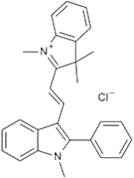Informations sur le produit
- (3E)-1-methyl-2-phenyl-3-[(2Z)-2-(1,3,3-trimethyl-1,3-dihydro-2H-indol-2-ylidene)ethylidene]-3H-indolium chloride
- 1,3,3-Trimethyl-2-[2-(1-methyl-2-phenyl-3-indolyl)vinyl]-3H-indolium chloride
- 1-methyl-2-phenyl-3-[2-(1,3,3-trimethyl-1,3-dihydro-2H-indol-2-ylidene)ethylidene]-3H-indolium
- 3H-Indolium, 1,3,3-trimethyl-2-[2-(1-methyl-2-phenyl-1H-indol-3-yl)ethenyl]-, chloride
- 3H-Indolium, 1,3,3-trimethyl-2-[2-(1-methyl-2-phenyl-1H-indol-3-yl)ethenyl]-, chloride (1:1)
- 3H-Indolium, 1,3,3-trimethyl-2-[2-(1-methyl-2-phenylindol-3-yl)vinyl]-, chloride
- Aizen Cathilon Orange RH
- Aizen Cathilon Orange RL
- Astrazon orange R
- Basic Orange 22
- Voir d'autres synonymes
- Cationic Orange 22
- Genacryl Orange R
- Nabor Orange R
- Orange Astrazon R
- Sumiacryl Orange R
Basic Orange 22 is a fluorescent dye that belongs to the class of polycyclic aromatic hydrocarbons. It has been shown to have a high resistance to tumor metastases and is used in polymerase chain reaction (PCR) as a fluorescent probe for DNA, RNA, and protein synthesis. Basic Orange 22 has also been shown to be activated by cleavage of a disulfide bond in proteins, which results in the formation of an intensely fluorescent product. The structural analysis of this dye was carried out using LC-MS/MS methods. This dye can be detected at very low concentrations in both test samples and analytical methods.
Basic Orange 22 is used as a chromatographic agent for the separation of amino acids that are structurally similar. It absorbs at 280 nm and fluoresces at around 420 nm when excited by light at 366 nm wavelength.





